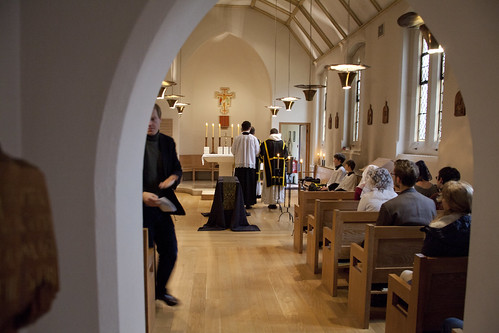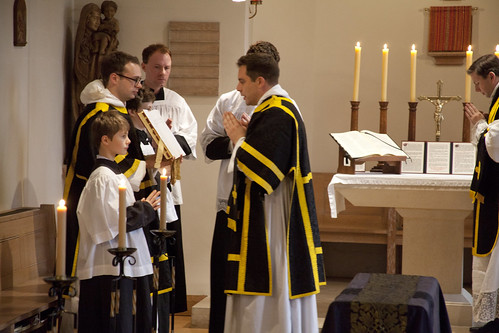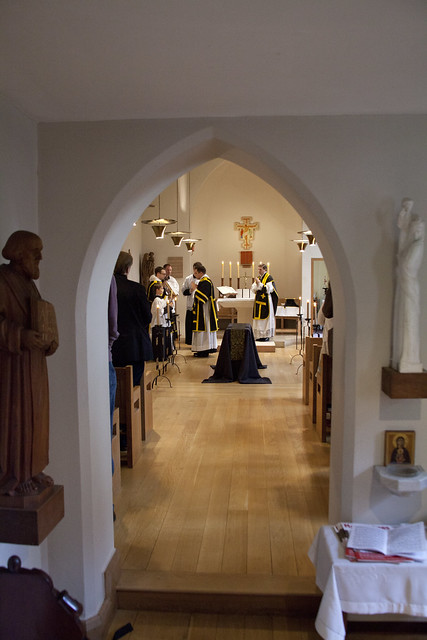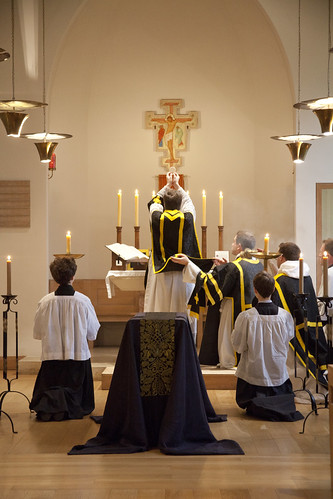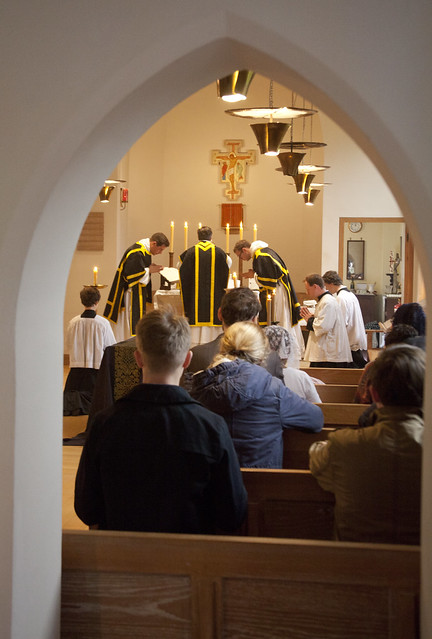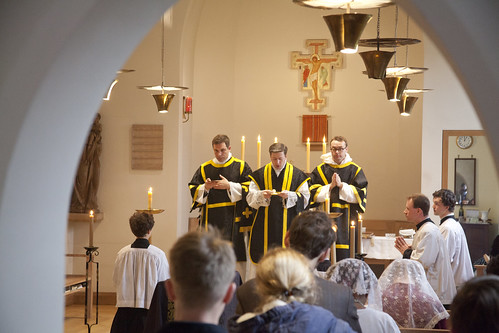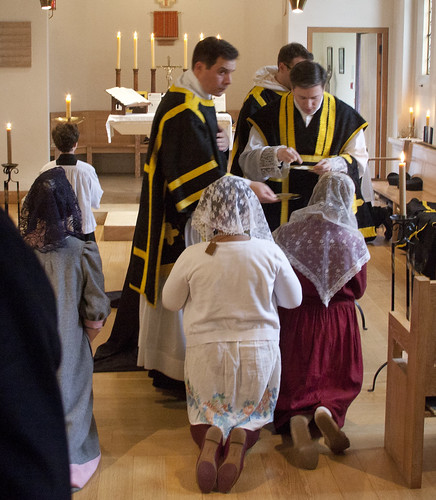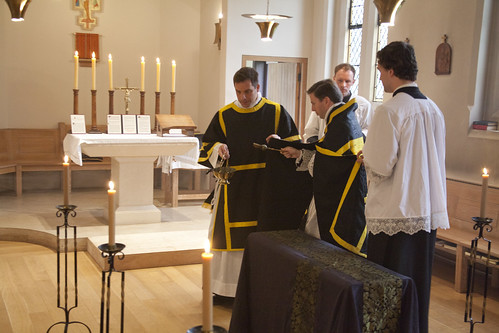Chairman's Blog
Update on Mgr Loftus
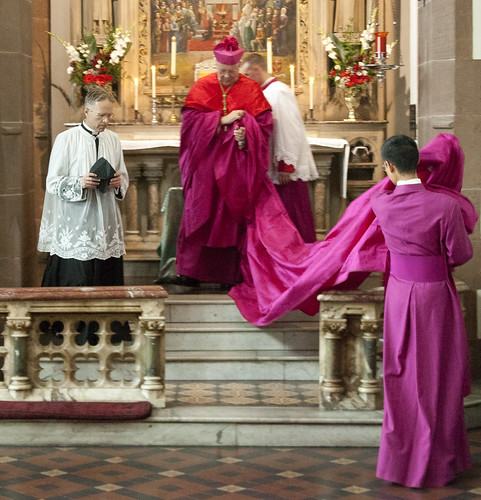 |
| Eat your heart out, Basil. That's Archishop Malcolm McMahon of Liverpool with the FSSP in Warrington, about to ordain two of their men priests. |
I've not been blogging about Mgr Loftus recently; he is terribly repetetive and I've said pretty well everything which can usefully be said, while other issues have arisen. However, since the big push I made about him in March 2015 a few observations may be of interest to my readers.
Long-term readers may recall that at that time I prepared a dossier of his jems, and I didn't keep this document to myself. Reviewing my ever-growing paper archive of his columns since then, it is clear that this had some effect. Mgr Loftus must have been given some kind of warning by person or persons of authority, whether it be bishops or the Editor of the Catholic Times in which his screeds are published. So my project was not a waste of time.
The most obvious indication is the number of times he has been attacking English, Welsh, and Scottish bishops by name, or by clear implication. In the years up to 2015, this habit was completely out of control. He attacked Bishop Hopes for pointing out the negative side of people going up to Holy Communion without thinking about it. He attacked Archbishop Mennini, the Apostolic Nuncio, for getting the Nunciature's central-heating system mended. (No, I'm not making that up.) He attacked Cardinal Nichols for versions of both crimes. He attacked Bishop (now Archbishop) Roach, then of Leeds, for getting a coat of arms. He attacked Bishop Doyle of Northampton for telling his priests not to allow teddy bears on coffins in funerals. He attacked Bishop Hugh Gilbert of Aberdeen because someone had defaced a notice on a noticeboard. On serveral occasions he attacked Bishop Davies of Shrewsbury and Bishop Egan of Portsmouth.
Not content with these targets, in the most appalling terms he attacked cardinals outside the UK, notably Ranjith, Müller, Bertone, and Burke.
Since then, the only negative references to British bishops that I found on my trawl through his columns (I may have missed some) have been to Bishop Keenan of Paisley on the funeral teddy bear issue, and 'Dr Egan, the Roman Catholic Bishop of Portsmouth', for saying that Amoris laetitia has not changed the Church's discipline.
It is scandalous (or ought to be) for a retired Monsignor to attack by name bishops of his former and current countries of residence, in a Catholic newspaper sold in their dioceses, for the crime of maintaining the Catholic Faith. However, in the context of his earlier columns this is astonishingly restrained.
On foreign bishops and cardinals he clearly feels less need to hold himself back, and there are ferocious assults on American bishops Morlino, Cordileone, and Chaput; on Léonard, the retired Archbishop of Brussels; on Archbishop Gänswein; on the Polish bishops; and (lots of times) on Cardinals Burke and Sarah.
Since 2015 he has become bolder in his attacks on Humanae vitae and the Church's teaching on contraception. The unlawfullness of contraception was denied in his columns on 4th Sept 2015, 10th June 2016, and again on 9th Sept 2016.
He has become bolder about the ordination of women as well, making his position unmistakable on 17th March 2017.
The issue which seems to get his goat the most (if the expression may be excused), however, is the celebration of Mass ad orientem. He can't stand the 'Reform of the Reform' and detests the Extraordinary Form, but it is ad orientem which is most consistently mentioned as a specific problem, beating even the hieratic language of the 2011 English translation of the Missal (and that's saying something). Readers were privileged to peruse the great man's rants on the subject on 27th March 2015, 8th April 2016, 28th October 2016, and this year so far on 28th July, 1st Sept, and 22nd Sept.
My conclusions from this are several.
First, it is a mistake to imagine that Loftus is immune to pressure: he has obviously felt it and responded to it.
Second, it is a great pity that the pressure didn't extend to ending his column altogether, because even from the perspective of a bishop at the liberal end of the spectrum of opinion, his columns are embarassing, and undermining of the respect due to ecclesiastical office. For example, the bishops have decided not to reopen the Missal translation issue, and would like everyone to stop attacking it and just let it bed in, but Loftus will not shut up about it.
Third, Pope Francis has been well recieved by the Loftus column, but although many inches have been devoted to ramblings about 'mercy', Loftus' agenda remains his own. It is not possible to defend Loftus' remarks on women priests or contraception on the basis of Pope Francis' words, and as for celebrating Mass ad orientem, if this is a crime then Pope Francis is a criminal too.
Fourth, Loftus continues to demonstrate that mainstream liberals in the Church are far more embittered, and far ruder about bishops, than equivalently mainstream conservatives or traditional Catholics.
No doubt some will tell me Loftus is not 'mainstream', but all I mean is that he has a huge weekly column in the Catholic Times, sold in Catholic churches up and down the land, his name appearing fortnightly on the mast-head to advertise the fact. It is further adorned, and its prestige underlined, by a photograph often so vast as to leave little room for anything else on this broadsheet page. He is allowed apparently infinite space to reply to his critics in the Letters Page, and the Editor publishes the most pathetic imaginable letters of support for the old booby, suggesting he does not have many to choose from. This is supposed to be the 'serious' Catholic newspaper, read by serious people, in contrast to the more low-brow Universe. And for all this, it remains acceptable for this column to decribe two Cardinals of the Roman Church, Sarah and Burke, as 'rigid reactionaries' (9th December 2016), as if it were the record of school play-ground.
But as a wise man once said: 'Being censorious of others is often a defence-mechanism to justify our narrow-mindedness.' (Mgr Basil Loftus, 12th September 2014).
Tu dicis, Basil: tu dicis.
Support the work of the LMS by becoming an 'Anniversary Supporter'.
Prayers for Advent and Christmas: Booklet

If you want to mark Christmas as a spiritual, and not merely bodily, feast, then buy this booklet of traditional prayers for the season, compiled mainly from the Raccolta, the old manual of indulgenced prayers.
My particular favourite is a Novena from the 16th to the 24th 'of any month', in honour of the nativity. It obviously has special appropriateness in December, and maintains the spiritual character of the busiest part of Advent.
The LMS on-line shop has a big range of Catholic items for Christmas: cards, advent calendars, nativity scenes, books and gifts. Go and have a look!
And if you are a member, don't forget to log in to get your 5% discount.
From the booklet's contents page:
CONTENTS
A Note on Indulgences
Pious Exercises
Prayers in Honour of the Nativity of Our Lord
Novena
Sequence of Prayers
Prayers for the Feast of Christmastide
The Nativity of Our Lord
The Circumcision & The Holy Name
The Epiphany
The Holy Name of Jesus
Litany
Other Prayers
Prayers From Other Sources
Blessing of the Advent Wreath
Alma Redemptoris Mater
Prayers Before the Crib
The Holy Innocents
Support the work of the LMS by becoming an 'Anniversary Supporter'.
Disappearing 'Catholic Guilt' or disappearing Catholics?
Reposted from March 2013. This reflects the ecclesial situation before Pope Francis, but the observations about the nature of the 'Catholic population' identified in surveys is still relevant.
--------------------------------------------------
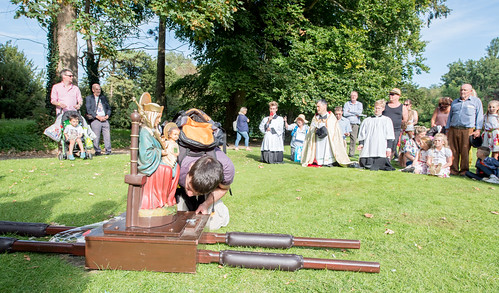 |
| Venerating Our Lady of Walsingham at the conclusion of the LMS Pilgrimage |
The Sensible Bond draws attention to a little-reported survey of attitudes which claims that Catholics feel little or no more compunction about immoral behaviour than the general population. He links that to the recent scandal about Cardinal O'Brien - which is very interesting, but here I'm just going to focus on the survey.
The Religion and Society Programme of the University of Lancaster has a helpful page with details of a long list of 'research findings'. The stuff about Catholic guilt is not to be found there, however, but in a press release. It is based, not on a study by sociologists, but an opinion poll by YouGov. The sample size of more than 4,400 sounds impressive, but it was conducted over the internet, and they only reached 391 self-described Catholics. This self-description, translated, in the Press Release, into the term 'practicing Catholic', comes down to whether they 'currently engage in religious or spiritual practices with other people, for example attending services in a place of worship or elsewhere, or taking part in a more informal group', where the 'group' etc. is Catholic for 'Catholics', or Anglican for 'Anglicans'. There is no reference to frequency of this vague spiritual interaction, so it would presumably include non-baptised people who go to their late work-colleagues' Catholic funerals once a decade. And if readers don't know a lot of serious-minded Catholics who'd never find themselves filling in an on-line poll, they need to get out more.
So I'd assume the survey would come out with results typical of the vast number of more-or-less lapsed Catholics, the sort of people who turn up at Midnight Mass and the occasional funeral. What does it say about them? This is the nub of it.
|
Would feel guilty if
|
All
|
All non-religious
|
All religious
|
CofE
|
RC
|
Baptists
|
Pente-costals
|
Muslims
|
Jewish
|
|
Used pornography for sexual stimulation
|
26%
|
15%
|
33%
|
30%
|
30%
|
69%
|
89%
|
54%
|
31%
|
|
Used contraception
|
5%
|
3%
|
6%
|
3%
|
9%
|
7%
|
9%
|
23%
|
3%
|
|
Had pre-marital sex
|
13%
|
5%
|
20%
|
12%
|
19%
|
50%
|
76%
|
62%
|
12%
|
|
Had extra-marital sex
|
56%
|
48%
|
64%
|
60%
|
57%
|
88%
|
89%
|
69%
|
72%
|
It is clearly not the case that a (probably tenuous) connection with the Catholic Church makes no difference to attitudes. Catholics are twice as likely as non-religious people to see the moral seriousness of pornography, and nearly four times more likely to feel guilty about pre-marital sex. Fornication is not just accepted by secular society, it is pretty well required: to hold out against it is to make an extraordinarily strong statement, with huge implications for one's personal life. And yet a fifth of these 'Catholics' would feel guilty about it. Ok, so the Pentecostalists, Baptists and Muslims do better, but these groups are sociologically incomparable with the Catholic population, let alone the 'Catholic' population, and the sample sizes for those groups are scarcely statistically usable. The reported views of Pentecostalists, for example, are based on the mouse-clicks of only 25 people.
 So to some extent we have a re-run here of the infamous survey in the USA which said that 98% of Catholic women were using contraception. (It turned out that NFP was taken as a form of contraception, and everyone wanting to conceive, unlikely to conceive, or not sexually active, was excluded.) However I don't entirely disagree with the Telegraph headline writer: 'Catholic Guilt is a Myth'. The reality is that we have two or even three 'Catholic Churches' to consider.
So to some extent we have a re-run here of the infamous survey in the USA which said that 98% of Catholic women were using contraception. (It turned out that NFP was taken as a form of contraception, and everyone wanting to conceive, unlikely to conceive, or not sexually active, was excluded.) However I don't entirely disagree with the Telegraph headline writer: 'Catholic Guilt is a Myth'. The reality is that we have two or even three 'Catholic Churches' to consider.
One is the hard core: the people who go to Mass every Sunday, and take it seriously. Yes, the do exist. I don't mean only people committed to the Traditional Mass, though they are certainly included in this. There are large bodies of very committed 'conservative' Catholics who can be found in selected 'conservative' parishes up and down the country. I've no idea how many there are - that's the frustrating thing. But they can be found among readers of the Catholic blogs and the Catholic Herald, they show up at Latin Mass Society, Evangelium, and Faith Movement events, they staff and support the pro-life groups, and they buy the books produced by Baronius Press, Ignatius Press, and Gracewing, sometimes from St Anthony Communications. We'd certainly notice if they disappeared. From what it is possible to tell, this constituency is growing, not declining.
Then there are the 'Catholics' who have some family connection with the Church, very often reinforced, rediscovered, or just invented for the sake of attending Catholic schools, or for the purpose of having a wedding in a Catholic church. There might be a religious image in the home because it was granny's. They are aware that the Church teaches that fornication and contraception is wrong, and they would describe people who follow this teaching as 'good' (perhaps as 'good-goody'), but despite being baptised and (often) confirmed, they take no notice of that at all. Perhaps a moral theologian could generalise about the likelihood of such people dying without a mortal sin on their souls. The existence of the Catholic school system maintains the numbers of this group, as a sort of penumbra around the visible Church.
More problematic is the third group. I am thinking of more or less 'churchy' people who go to Mass and perhaps get involved in their parishes, but, when asked, turn out not to believe in biblical inerrancy, transubstantiation, the Immaculate Conception, or the Virgin Birth. Their moral attitudes are those of their secular neighbours, but being more self-conscious about their faith than the second group, they don't just ignore the teaching of the Church, but positively reject it. Their understanding of their relationship with the Church, and the Church's teaching authority, is essentially Anglican. You find these people everywhere, but the age-profile of this group is very tilted towards the 'Vatican II generation', and the Grim Reaper is cutting them down in rows. In twenty years time they will have all but vanished. The letters pages of the Catholic press will be unrecognisable.
The Sensible Bond is correct in saying that Catholic schools and parishes, and the Church in general, have failed to inculcate into most of the 391 people taking this survey the truths of the Faith. But once we break it down, it is easy to see why. For the second of my three groups, there hasn't been any real interest in the Faith since granny passed away, and catechising them at a Catholic school must be like preaching to the heathen. For the third, they postively rejected the teachings of the Church, or most of them, forty years ago (maybe when Humanae Vitae came out), and linger in the pews solely in the expectation that the Church will come round to their own way of thinking. Teaching them, from the pulpit of a Catholic church, must be like appearing on the podium at a Humanist Association meeting.
I'm not saying that catechism in schools and the teaching coming from bishops and others has been as clear and forceful as it should be - certainly not. But there is a reason for this lack of clarity and forcefulness. It is designed, quite deliberately, to keep the second and third groups on board.
What happened in the 1970s was an unprecedented collapse of church-going by adult Catholics. But that was, in fact, only the visible half of an even bigger apostasy. A whole lot more people ceased to believe the Faith in and around that decade, but carried on with some nominal affiliation to the Church; thanks to the allure of Catholic schools, this nominal affiliation can even be passed on to the next generation. In order to maintain the fiction that the Church is far bigger than my first group alone, bishops and catechists have gone to a lot of trouble not to frighten them off, even if they are not members of the second or third groups themselves (as most 'Catholic' school teachers today probably are).
Of course this has made the situation much worse, over time, and has delayed and minimised the revival which is today, finally, beginning to be visible. But rather than say that more than three quarters of Catholics think fornication is morally fine, let us recognise that more than three quarters of the people ticking 'Catholic' on on-line surveys are nothing of the kind, and (with their parents) in most cases haven't been for forty years.
It is a very open question whether the second and third groups will stick around as the great pincer-movement we see beginning really starts to bite: I mean the pincer-movement composed of state persecution, from one side, and newly appointed, orthodox bishops and priests, on the other. I would guess they will find things too hot for them, and their nominal affiliation to the Church will be withdrawn. When that happens, we should recognise that this is to a large extent the after-shock of the apostasy of forty years ago.
They went out from us, but they were not of us; for if they had been of us, they would no doubt have continued with us: but they went out, that they might be made manifest that they were not all of us. (1 John 2:19)
The Traditional Movement and orthodoxy: Chairman's message
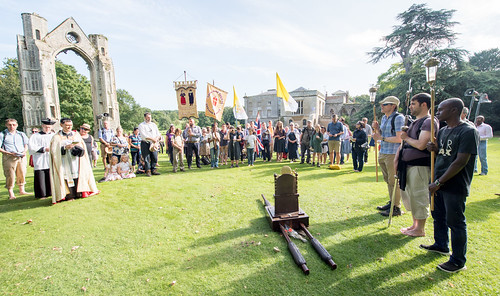 |
| The Latin Mass Society pilgrimage to Walsingham, at the site of the Holy House |
For those who've not seen the latest Mass of Ages, the magazine of the Latin Mass Society, here is part of my 'Chairman's Message'.
----------------
Support the work of the LMS by becoming an 'Anniversary Supporter'.
Photos of St Benet's Requiem
The annual Traditional Requiem, sponsored by the Latin Mass Society, took place yesterday; here are some photographs.
Celebrated by Fr Edward van den Burgh of the London Oratory, assisted by Fr Nicholas Edmunds-Smith of the Oxford Oratory and Br Albert Robertson OP.
Mass was accompanied by the Schola Abelis of Oxford under Dominic Bevan.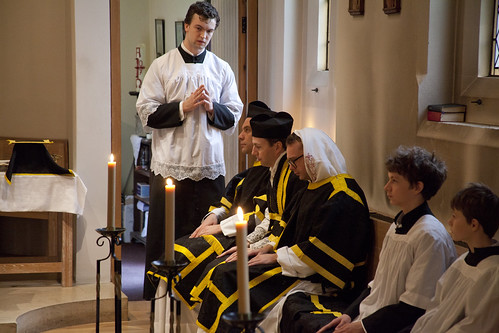
I am very grateful to Fr John Saward of SS Gregory & Augustine's for the loan of the candlesticks and other items used in the Requiem.
'Not in the hands of boys, but in their eyes,
Shall shine the holy glimmer of goodbyes.' (Wilfrid Owen.)
No candles at the Gospel: the acolytes stand by the deacon singing the Gospel, but without their candles.
This isn't the first time I've managed to organise a High Mass for this occasion, though most of these, since I started them in 2013, have been Sung Masses without deacon and subdeacon. With the catafalque, there is not an abundance of space, but it is possible.
I organise Masses in a number of rather small churches and chapels, and the small catafalque (which is a console table the rest of the time), with the pall which covers it exactly, has been in many of them. The rather small thurible I also aquired with such chapels in view, which tend to be the ones without thuribles of their own.
In St Benet's there is an additional difficulty of celebrating ad orientem with the altar close to the edge of the step. The footpace used yesterday is a wooden platform made specially for this purpose.
The capacity of the chapel is extremely limited, but a decent crowd came along.
May the deceaed alumni, staff, and benefactors of the Hall rest in peace.
Support the work of the LMS by becoming an 'Anniversary Supporter'.
The New Age and the Old Mass
 |
| Milton Manor House, Oxfordshire |
Today I am publishing a new Position Paper from the FIUV on the New Age. Go over to Rorate Caeli to read it. Here I present some background and further reflections.
A few years ago on the LMS Walking Pilgrimage to Walsingham I noticed that four of my fellow pilgrims were converts to the Catholic faith from Buddhism. Buddhism is not a major religion in the UK, so the coincidence was rather remarkable. Indeed, in a number of obvious ways Buddhism presents a very marked contrast to Catholicism, and traffic between Buddhism and Catholicism tends to flow the other way. In fact, three out of these four pilgrims had been Western converts to Buddhism, before they came to the Catholic Church.
Buddhism in the West is part of a wider phenomenon, of the attraction posed by eastern spirituality to post-Christin or nominally Christian westerners. This eastern spirituality is often somewhat re-packaged for western tastes, and only the most serious-minded go the whole hog and become Buddhists. Far more popular are the (apparently) nice bits of eastern spirituality, such as reincarnation and the idea of self-realisation, without the asceticism and the infinitessimal prospects of success. Add these to a bit of Tarot-reading, Astrology, the 'all-religions-are-one' dogma of Freemasonry, and other bits of Western-inspired clap-trap, and you have the New Age Movement. This soup of influences is united by the idea that we can free ourselves from soul-cramping restrictions imposed by bad upbring, traditions, and habits, by spiritual techniques, such as meditation, perhaps aided by Yoga, or maybe even drugs.
It is easy to make it sound silly, but it is ubiquitous. We no longer live in a Christian society, but that does not mean there is no spiritual narrative guiding people's lives. Instead of seeking salvation and transformation by Christ, a high proportion of the other people on you local bus would probably agree that they are ultimately concerned with gaining self-realisation through techniques: as the New Agers say, by 'working on themselves'. It may be positive thinking, it may be the gym, it may be a new diet. But it is spiritual, in the sense that it concerns what is most central to them, and what, if anything, has transcendent value. Of course they may not use these terms, but we can determine that we are not simply dealing with material ambition, whether healthy or pathological, because it is about making themselves not just better off, but better people. In this sense, it has replaced religion in their lives - even if some of them still pop in to church occasionally.
Not all of the people on the bus who think about the kind of person they want to be can, in the end, work up the energy to give up red meat, take up Yoga, lose two stone, or whatever it is they think might help. It remains true, however, that, instead of seeking salvation from Christ, they are seeking, well or badly, self-realisation through techniques. If they are to convert to Catholicism, they will need to give up the idea that their ultimately important destiny is some vision of self-perfection. They will have got to accept, what they or their parents or grandparents rejected, the Christian narrative of sin, grace, and redemption, an external and personal God, and an eternal heaven and hell.
The New Age spiritual narrative, as I have described it, has replaced the Christan one for most of the population of the English-speaking world since the 1960s. Even if the hard-core, self-identified, tofu-eating, sandal-wearing, New Agers are relatively few, in this more general sense their ideas have won.
It is a matter of no small interest, then, why they have won, and how this victory can be reversed. I was able to consult a good number of Traditional Catholics who had spent time in the the New Age and Occult milieu, to help with the development of this Position Paper. Thus is not just armchair theorising: it is informed by first-hand experience.
So here in a nutshell is the argument of the paper. If the New Age spiritual narrative won, it must have been more attractive than the alternatives apparently available. The New Age is, among other things, a revolt against rationalism and moralism, and a search for the mysterious and transformative. The major alternative in the English-speaking world in the 1970s was a Protestantism which has ceased to believe in itself, and had never been very good at offering its adherents transformative mystery, in liturgy and spirituality. Catholicism, which had been good at doing that, quite suddenly stopped doing it, just at the moment the New Age was gaining momentum.
Here's the pitch. You're not being offered anything impressive or exciting by conventional religion? You are feeling a bit depressed and a bit uptight? Use these techniques to unlock your inner potential because, yes, you are a wonderful person, if only you knew it, and you just have to free yourself.
Those who do try the techniques can feel a bit buzzy and euphoric, and when that wears off there are more, stronger, techniques to try. Some of them contain perfectly genuine benefits, to health for example. Some are very dangerous. But you'll be dead long before you've tried them all.
The Church can't combat this by offering some watered-down New Ageism. It can offer the profound in place of the superficial, the objective in place of the subjective, and the real in place of the fake. It can offer a transcending mystery which really can heal and transform. It can open the door the New Ager is knocking on. The traditional liturgy is the ideal means to do this.
Click on the label 'New Age' to see other things I written here about it.
Support the work of the LMS by becoming an 'Anniversary Supporter'.
Bishop Li in
 |
| Bishop Li in 2013 |
Bp. Joseph Li Side, an 'underground' bishop consectrated secretly, died this morning (11:20pm GMT), aged 97. Please pray for him.
Bp. Li was a pillar of traditionalism, as well as of true fidelity to the See, in the Chinese speaking Church.
In his nineties he translated the 1962 missal into Chinese, to aid Chinese speaking clergy in the understanding of the prayers. This massive project will continue to be of great significance for Chinese Catholics far into the future.
On a more personal level, he and some of the priests in his diocese gave the old mass movement much support.
The Novus Ordo Missae was not introduced into China until the 1980s, so there remains a generation of priests who were taught the the ancient Mass in seminary. See the FIUV Position Paper on the Extraordinary Form and China.
There is a little more about him and his activities in this UCA News report.
Support the work of the LMS by becoming an 'Anniversary Supporter'.
Annual Requiem in St Benet's Hall, Oxford
Support the work of the LMS by becoming an 'Anniversary Supporter'.
Priest Training Conference, Low Week 2018
The LMS Priest Training Conference is back! It didn't happen last year because of the late Easter (Low Week was in term time at our venue, Prior Park).
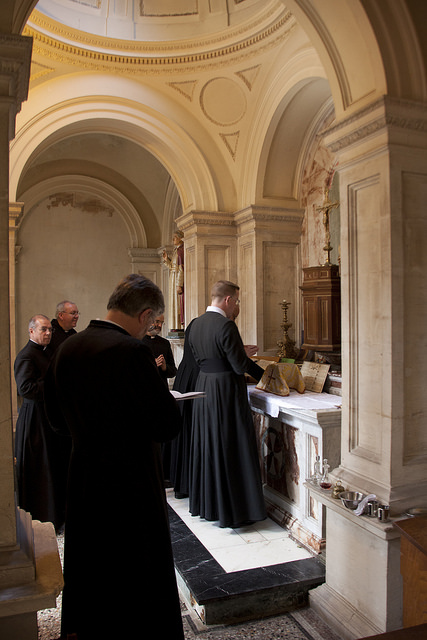
Tuition will be in small groups. For clergy and seminarians, this will be provided by priests experienced in the Extraordinary Form, for servers this will be provided by laymen with years of experience in the Extraordinary Form.
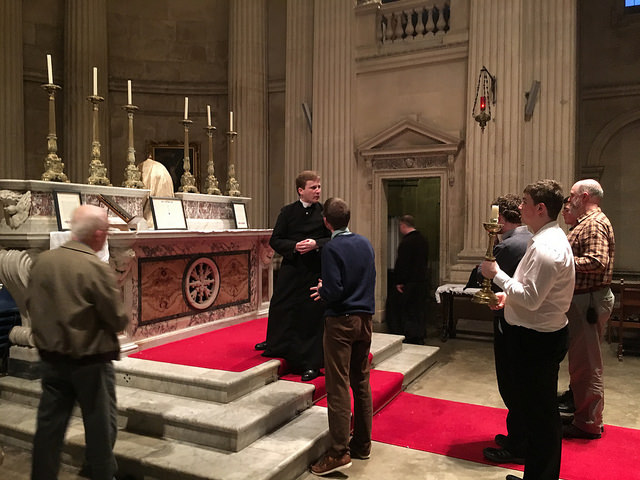 The conference will start after lunch on the Monday and conclude before lunch on the Thursday.
The conference will start after lunch on the Monday and conclude before lunch on the Thursday.Full-time students: £60
Seminarians: FREE OF CHARGE
Support the work of the LMS by becoming an 'Anniversary Supporter'.
Autumn Mass of Ages now available
In this issue:
• Bishop Michael Campbell OSA, Bishop of Lancaster, leads us in to the great liturgical seasons of Advent and Christmas with a thought-provoking meditation
Feature on St Augustine's, Ramsgate:
"Augustus Pugin is a name that should be on the lips of every Catholic in England... He became one of the most influential architects and designers of the nineteenth century, championing Catholicism and the Gothic style in everything…
"He said that building a church was the greatest thing a man can do, and that is precisely what he did in Ramsgate. For the greater glory of God, he created this ideal church where God could be worshipped according to the ancient rites of our Holy Mother the Church.”
St Augustine's was the home of The Victoria Consort. Recorded in the Shrine, their CD traces, in Gregorian Chant, the arrival of St Augustine in Kent and the re-establishment of Christianity in England from AD 596.
Feature on the Crib:
"...no Catholic family home is complete, at Christmas, without a Crib: a three-dimensional representation of the Stable at Bethlehem, with its inhabitants” writes Joseph Shaw. “The history of the Crib is an interesting one. It is clearly a cousin of the Medieval Mystery Play, another way of representing and making vivid key scenes from Scripture, which embedded them in the late Medieval Catholic imagination… The crib is a visual Gospel [a point made by Bishop Campbell in his meditiation] and its place in churches is entirely appropriate, as well as in private homes.”
Nativity scenes for your home are available from the LMS online shop.
Book review: Una Voce: The History of the Foederatio Internationalis Una Voce 1964-2003
“Leo Darroch’s important book contains valuable insights into every major development in the treatment of the Traditional Mass over the long period of time it covers, and makes clear the important role of the FIUV. It will be an indispensable work of reference for scholars and historians,
as well as being of interest to anyone who wants to become well informed about the treatment of our liturgical patrimony during its long time in the wilderness.”
Leo Darroch was a member of the LMS Committee from 1986 until 2012; Deputy Chairman to Christopher Inman, and converted the old-style A4 typed reports into a modern magazine style in the early 90s.
Read the full review in Mass of Ages. Better still, buy the book and read it for yourself!
Also included:
Shaun Bennett remembers the Rev. Dom Antony Tumelty OSB.
Matt Showering reports on Tolkein’s devotion to the Blessed Sacrament.
Clare Bowskill reports from the recent LMS Latin Course.
Alisa Kunitz Dick tells about her experiences of teaching Latin and Greek to children.
Our regular columnists:
• Alberto Carosa reports on the 6th Summorum Pontificum Pilgrimage to Rome
• See photographs of our own celebration for the 10th anniversary of Summorum Pontificum
• In her Art and Devotion series, Caroline Shaw looks at The Nativity by Piero Della Francesca
• Mary O’Regan on the significance of the number 13
• Fr Bede Row asks, “Do we still believe in the Devil?”
• The Lone Veiler on ‘The war against women’
Thanks to the cooperation of priests in whose parishes the Traditional Mass is celebrated, Mass of Ages is available from more than 115 cathedrals and churches around the country. If you do not live near one of these but would like a copy of the magazine, we would be very happy to send one from the LMS Office. However, due to the high cost of postage, we do ask that you cover the cost of postage. See here for details.
To help the Latin Mass Society continue its work of promoting and developing Traditional Catholic life and practice in the Church, please consider signing up to our Anniversary Supporters’ Appeal.
A digital copy of the magazine may be read HERE(link is external).
Thanks to the cooperation of priests in whose parishes the Traditional Mass is celebrated, Mass of Ages is available from more than 115 cathedrals and churches around the country. If you do not live near one of these but would like a copy of the magazine, we would be very happy to send one from the LMS Office. However, due to the high cost of postage, we do ask that you cover the cost of postage. See here for details.

